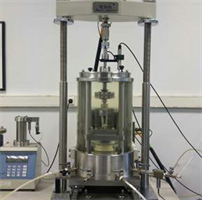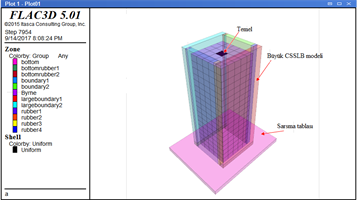In the scope of this research, liquefaction response of sand sites under an existing superstructure and mitigated by IPS will be investigated through numerical modeling, and the analysis of the behavior will be also explored under cyclic simple shear strains. Formulation of a mathematical methodology/model is aimed to predict excess pore water pressure ratio and volumetric strain in partially saturated sands in free field or under a structure during earthquake motions.
You can find the detailed explanation about the project, coordinated by Assist. Prof. Dr. Esra Ece Bayat, below.


Project Title: Dynamic response of sands mitigated by IPS (ınduced partial saturation) under new and existing structures
Project Number: TÜBİTAK 3501 - 213M367
Project Coordinator: Assist. Prof. Dr. Esra Ece Bayat
Abstract:
Projenin İngilizce Özeti:
The potential vulnerability of existing structures on liquefiable soils continues to be of major concern not only to individual owners but also to the public that faces destruction of their cities, towns, and neighborhoods. Liquefaction causes fully saturated loose sands to lose their shear strength mainly due to excess pressure build-up in incompressible water in the sand
pores during a dynamic excitation. The excess pore water pressures developed can be high enough to overcome the contact stresses (effective stresses) between the soil grains, causing the soil to lose its strength. Unfortunately, extensive failures and damages have been experienced by our communities due to liquefaction of the soil during earthquakes, not only in our region but also in the world countries. An urgent need exists to develop cost-effective liquefaction mitigation measures that can be easily and widely used for new as well as existing structures or critical structures such as historical or cultural heritage. The proposed research focuses on the development and implementation of a new liquefaction mitigation technique: Induced PartialSaturation (IPS) that has been recently proposed and investigated by Prof. Mishac Yegian and Dr. Ece Bayat. The IPS technique involves generation of gas bubbles in loose saturated sands thus inducing partial saturation leading to not only strength gain against liquefaction, but also potentially eliminating the occurrence of liquefaction under any size earthquake.
The new liquefaction mitigation technique IPS holds promise to be more practical, relatively cost-effective and applicable to existing and/or critical structures such as historical and cultural heritage. IPS intends to prevent the occurrence of liquefaction by increasing the compressibility of the pore fluid with the generation of some amount of gas in the fully saturated sand pores, thus basically by transforming the sand into partially saturated state. Preliminary shaking table laboratory results performed by Eseller-Bayat vd. (2013 (I)) demonstrated that excess pore water pressure ratio (ru=Δu/'v) significantly reduced as the degree of saturation decreases in liquefiable sands. The ultimate goal of this proposed research is to provide a fundamental understanding of the benefit of IPS technique on liquefaction prevention and to further explore the introduction of air as a cost-effective measure to mitigate liquefaction-induced damages to new and, more importantly, to existing structures. In order to achieve this goal, following tasks are set:
1) Parametric study of the experimental data from shaking table tests.
2) Liquefaction Response of typical free field liquefiable sand sites for fully saturated sands and partially saturated sands for a range of earthquake and soil parameters through
numerical modeling, development of a constitutive model (effective stress model) for partially saturated sands, the analysis of the behavior of fully and partially saturated sands under cyclic simple shear strains and the comparison of the numerical analysis results with the experimental data from shaking table tests.
3) Liquefaction response of sand sites under an existing superstructure and mitigated by IPS through numerical modeling, and the analysis of the behavior under cyclic simple shear
strains.
4) Formulation of a mathematical methodology/model to predict excess pore water pressure ratio (ru) and volumetric strain (v) in partially saturated sands in free field or under a structure during earthquake motions,
5) Implementation of the mathematical model into real IPS field implementation and estimation of partial saturation to be induced in liquefiable sites.
The results and outcomes of this research project will be disseminated through journal papers, conference presentations, media and website. In Literature, this research will shed lights to future research on developing new technologies to prevent earthquake-induced damages to our infrastructure. Since partial saturation is a new phase in geotechnical engineering area,
the behavior of partially saturated sands (having the air in the voids in bubble form) during earthquakes needs to be investigated. This research will contribute in Geotechnical Engineering area by developing a new constitutive model for the dynamic response of partially saturated sands. The researchers and engineers will benefit by using this model in their researches or in real case projects to analyze the dynamic response of partially saturated sands naturally existing in nature. Also, the mathematical predictive model that will be developed in this research will not only be used in the implementation of IPS but also in the estimation of excess pore water pressures and settlements in partially saturated sands existing in nature. Besides contributions in science and engineering, the ultimate goal of this research is to help the safety of our society. This research will have great contribution to the world-wide society safety and the protection of the infrastructure from earthquake hazards. If implemented in the field, IPS technique will help the economy of the societies by eliminating economic losses attributable to liquefaction especially in major metropolitan regions where existing structures are founded on potentially liquefiable soils by protecting the infrastructure including the existing critical or historical structures in a more practical and cost effective way. Through media and professional website, this project will raise awareness and interest in earthquakes and how to protect our lives and structures from devastating effects of earthquakes. The best outcome of this research will be to provide opportunities for the IPS technique to be implemented in liquefiable areas selected in Turkey and determination of partial saturation needed using the predictive model developed. This career grant will
enable the project investigator to build up her career in geotechnical earthquake engineering, collaborate actively and effectively with leading experts in the field in USA and publish technical papers to promote to higher academic title.